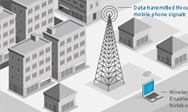Services
Wireless Local Area Network
Wireless technology is a new way of networking computers together without the traditional limitations and costs of a wired network. With wireless technology, you have the freedom to access your e-mail, the Internet - even your company network - anywhere you have access to a wireless network. And you can stay connected in public places like airports, hotels and restaurants. Where wireless access is available. Additional access charges apply in some locations.
Increased speed and the introduction of industry standards like IEEE 802.11b, IEEE 802.11g and 802.11a and WECA Wi-Fi have helped wireless networks offer cost-effective flexibility for growing businesses. Wi-Fi, or Wireless Fidelity technology, uses the same networking standards as Ethernet, or wired networks, with a comparable look and feel.
Why Go Wireless?
With Wireless products, it's easier and more affordable than ever to build flexibility into your business. Wireless can help your business save money, be more flexible and boost productivity. Whether you're in or out of the office, you can stay connected wherever a wireless network is available.
Here are just a few of the benefits of going wireless:
Increase Productivity
Work when and where you want with convenient access to local network resources and Internet connections. Installing a wireless network allows you to take your notebook anywhere in the office or access your network from outside the office, increasing your productivity. (Range and speed will vary due to environmental or other factors.)
Security
Wireless technology can provide users with the same type of security that exists on wired networks when used in conjunction with existing network security technology.
Fast Access
Get quick access to your network server. Share high-speed Internet connections and other network resources, such as documents, printers and other network peripherals.
Efficient Collaboration
Share files or exchange e-mails with your team on-site or off-site through a wireless network. Connecting to your company intranet is easy with access to a wireless LAN.
How it Works?
Wireless technology works much the same way a mobile phone works: airwaves, instead of wires, are used to carry data from one point to another. There are limitations to where you can access the Internet- you must be within range of an access point, the part of a wireless network that transmits data to your computer.
Different types of wireless network scenarios:
 Wireless Local Area Network (WLAN) - A WLAN creates a range that can reach up to 300 feet. You can connect to a WLAN from your office or public access facilities.
Wireless Local Area Network (WLAN) - A WLAN creates a range that can reach up to 300 feet. You can connect to a WLAN from your office or public access facilities.
 Wireless Personal Area Network (WPAN) - A wireless PAN device commonly has a range of up to 100 feet, freeing you from the limitations of wires and cords.
Wireless Personal Area Network (WPAN) - A wireless PAN device commonly has a range of up to 100 feet, freeing you from the limitations of wires and cords.
 Wireless Wide Area Network (WWAN) - A WWAN's range can reach up to 20 miles, offering users a way to stay connected while they're on the move, away from other network infrastructure.
Wireless Wide Area Network (WWAN) - A WWAN's range can reach up to 20 miles, offering users a way to stay connected while they're on the move, away from other network infrastructure.
Wireless Local Area Network (WLAN)
In a Wireless Local Area Network, a radio communications device called an access point connects network computers. The access point is small and lightweight with an antenna attached to it that sends data back and forth over the airwaves. The illustration above shows how a WLAN works in a typical office environment.
A single access point, like a router, has a range that can reach up to 300 feet (100 meters). (Range and speed will vary according to environmental and other factors.) An access point can extend the range of a WLAN.
Desktops and hand-held devices use PCI adapters, while notebooks access wireless networks through integrated wireless Mini-PCI cards and external network PC cards. Wireless-ready products include:
Wireless LANs are becoming more commonplace in public-access facilities, where users can reach speeds up to 11Mbps (based on IEEE 802.11b and Wi-Fi standards). To access a wireless LAN from a public place, you'll need an account with a wireless Internet service provider (ISP), like T-Mobile. Your wireless ISP can provide you with a list of places, called "hotspots", that are part of the same wireless LAN you access through your account. These hotspots contain access points that send out signals to the wireless network card in your notebook or PDA. (Range and speed will vary according to environmental and other factors.)
Wireless Personal Area Network (WPAN)
With a Wireless Personal Area Network, you can:
![]() Connect your system to a printer
Connect your system to a printer
![]() Sync a PDA
Sync a PDA
![]() Download images from a digital camera
Download images from a digital camera
![]() Transfer MP3 files
Transfer MP3 files
A PAN device usually has a range of up to 160 feet (50 meters).
Bluetooth is an emerging standard in Personal Area Networks, allowing the transmission of data between devices such as cellular phones, handheld devices like the Axim Pocket PC and notebook or desktop computers through short-range radio waves. With Bluetooth technology, you can complete business tasks like updating your calendar in your handheld device and then synchronizing the data with the calendar on your notebook computer.
Wireless Wide Area Network (WWAN)
Wireless Wide Area Networks transmit data using mobile phone signals, through a mobile phone service provider, with connection speeds equal to 56K* dial-up. Their range can reach up to 20 miles (30 kilometers), offering users a
Wireless Local Area Network

Wireless Local Area Network

WPAN





